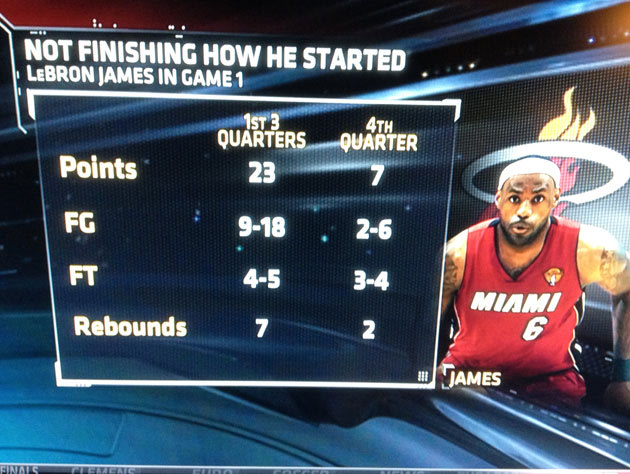Shortly after Game 1 of the NBA finals ended late Tuesday night, I found myself clicking around and looking for the postgame press conferences of Oklahoma City Thunder coach Scott Brooks
and Miami Heat coach Erik Spoelstra. (I know, I should've just gone to NBA.com and streamed it, but I didn't think of that right away.) In the search, I landed on ESPN's postgame coverage, which at that time featured the following graphic (captured by CBSSports.com's Will Brinson) breaking downLeBron James' Game 1 performance:
The intent is to seize on the notion that James shrinks late in big games, a widely held belief that certainly has some basis in reality but is also somewhat overblown, since "clutch" remains a pretty problematic construct that tends to ignore the critical non-highlight plays that can lead to wins in favor of harping on missed shots. But when the Heat lose, that means LeBron lost; when LeBron lost, that means we're going to be talking about whether or not he shrank late. Hence, the graphic.
Except ... look at the graphic. What part of the information there indicates that James "didn't finish how he started"?
The graphic tells us that through the first three quarters, James scored 23 points, while in the fourth, he scored only seven. Well, if you divide 23 by three, you get 7.66. His scoring average dropped off by a whole two-thirds of a point in the final 12 minutes.
It tells us that through the first three quarters, James hit 9 of 18 field-goal attempts, compared to just 2 of 6 in the fourth. Umm ... the average there is 3 for 6 through the first three quarters. So, one fewer make in the same number of attempts. OK.
It tells us that he went to the foul line nearly as many times in the fourth quarter alone as he did through the first three, finishing with nine total attempts for the game, and that he hit 3 of 4 from the stripe in the final frame.
It tells us that after bringing in seven rebounds through the first 36 minutes, he only had two in the final 12. Which, y'know, is a pretty precipitous drop from the 2.3 rebounds per quarter he'd averaged before the Big Bad Fourth. (He also had one assist in the fourth, right in line with the three he'd notched through the first three quarters; they didn't have room for that, I guess.)
It doesn't tell us that Dwyane Wade and Chris Bosh had awful shooting nights from the floor, combining to go 11 for 30 and scoring just 29 combined points, sending James out there to match baskets with Durant and Russell Westbrook mostly by his lonesome. It doesn't tell us that matching baskets against an Oklahoma City team that came into this series leading the playoffs in offensive efficiency isn't a recipe for success, which the Thunder proved in outscoring the Heat 83-65 after the first quarter and shooting 53.4 percent from the field after starting out 9 for 19 in the opening stanza. It doesn't tell you a lot of things.
What it tells you is that LeBron James didn't finish how he started in a game that Miami led at half and lost late, and it's not telling the truth. It's putting big numbers next to small numbers and saying "Look how different they are!" without noting that ... y'know ... there's a completely valid reason why one side's bigger than the other. And it's not even doing a really good job of it.
That's a really huge bummer, because an awful lot of people in an awful lot of phases of ESPN's operation often or always do a really good job of helping us understand the game. Read Henry Abbott on how remarkably easy Kevin Durant makes scoring look, or Tom Haberstroh on how Miami'sinability to get stops short-circuited its offense, or Sebastian Pruiti on literally anything he writes about X's and O's. You'll be smarter at the end, I promise. You'll learn something.
From this, though? All we learned is that it's easier to get and keep eyeballs if you say LeBron's a choker, even if the facts of this particular case don't back it up. The evidence is right there on your TV screen; you just might need to do a little quick mental math to figure it out. And when you're done, remember that Chris Webber's breaking it down on NBA TV just up the dial.

No comments:
Post a Comment